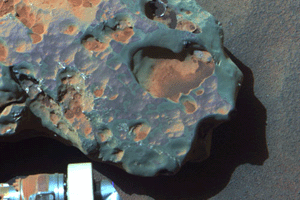 Close-up of a nickel-iron meteorite discovered on Mars by
Close-up of a nickel-iron meteorite discovered on Mars by
the rover Opportunity. Image Courtesy of NASA.
Trundling along the wind-swept plains of Meridiani Planum, NASA's Mars rover Opportunity stumbles upon yet another rock that looks like it could be an iron meteorite. Does the image of a Gold Rush era prospector leading his burro across desert sands and pecking at a rock with a hammer come to mind? Ah, but more precious than gold is common sand and stone when it's on Mars!
Sounds a bit lonely, like the lives of real gold prospectors; right now, Opportunity is the only active explorer on the surface of the entire planet, surrounded by the now eternally sleeping derelicts of the Vikings, Pathfinder, Spirit, Phoenix, and a few lost souls like Beagle and some Soviet landers….
But, it really is an amazing time to be alive. Each new report from our exploration of space—Mars in particular—reminds me of the state of our knowledge of the solar system when I was a starry-eyed child, back in the 1960s. I recall having to imagine what the surface of that planet might look like; I remember poring over pictures in books and posters of artists' concepts of what the Martian desert might be like, or the even more mysterious shrouded surface of Venus, or how a scene of Saturn and it rings from the surface of one of its moons—Titan, Enceladus, Iapetus--might look.
